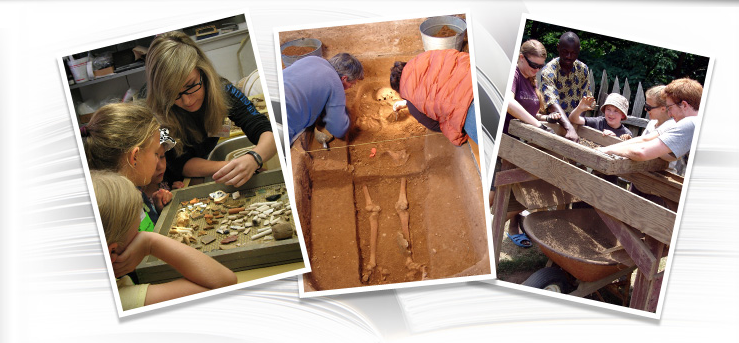2013 Week 4
This turned out to be a very busy week on the site with many visitors. Among other things, we had a visit from the Jamestown Field School and, on Saturday, quite a few of the people who came to attend Beerfest stopped by to see us. We have always thought of our work as a public exhibit and go out of our way to bring people on the site. Students are encouraged to interact with them, showing them what we find, talking about how we find it and why we are looking for it. We are excited about what we do and it feels good to share it.
This week we finished the last of the units north of the reconstructed fence. Most of them had few features and what was found turned out mostly to be fence posts representing the many generations of 19th- and 20th-century fences along the Brome house driveway. One unit did find a 17th-century fence running north from the foundation.
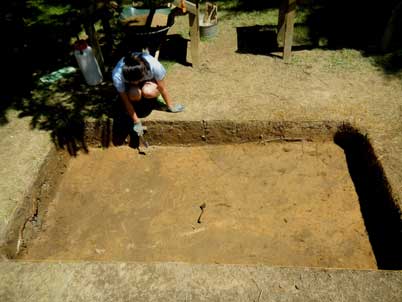
A student points to the fence line discovered north of the
reconstructed fence.
This was the reason we began testing this area and it is now confirmed that at least some of the fences extend beyond the defined site boundary. There are a few small details yet to be recorded but, after that, the tractor will come out and fill in all of these holes. It will probably be an emotional moment for some of the students as their first excavated units disappear back into the earth.
The students have spent parts of many mornings completing the unbackfilling of units which will be further investigated. One of these areas contained a covered cellar which we had defined over the past two seasons. This feature consists of a large hole for storage that was covered by a small building. In this case, there were four post holes around the cellar. To get back to the feature, the students had to remove well over a foot of soil before getting down to the plastic marking where we stopped excavation. On Saturday, we completed cleaning up the last of the fill, took up the plastic and, for the first time, uncovered the whole feature.
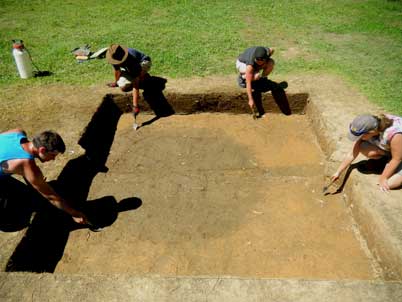
Covered cellar with students pointing to each of the post molds.
Each of the students in the photo points to the location of where a post once supported the structure. The cellar itself is easy to see, being very round and dark. There is a fence line trench that runs through the top of the cellar fill, indicating that the cellar was filled in and the building gone, by the time the fence was created. Based on the location, this fence might be part of Pope’s Fort, a 1645 fortification. If so, the cellar was a very early feature on the site. Next week, we will begin to excavate the fence line and when that is removed, test the cellar itself.
A couple of interesting artifacts have been found this week. The first was a small, rolled tube of copper.
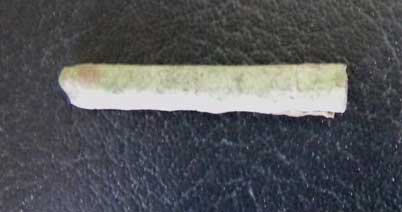
Rolled copper tube, possibly an aglet.
While it does not look very impressive, it may be what is called an aglet, or the end of a lace or string. As I told the students, to know what this might be, all they had to do was look at the plastic coating on the end of their shoelaces. In a culture where most clothes had laces rather than buttons or zippers, aglets were very common. It is also possible that this might be a copper bead. In any case, it was an unusual find.
The other artifact was both more understandable and more exciting.
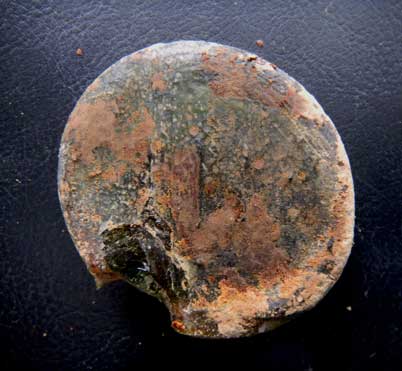
A bottle seal with the initials “IB” representing John Baker.
The photo shows a wine bottle seal with the initials “IB” in the center. These have been found on sites associated with John Baker. The Calvert house lease was purchased by John Baker in the 1670s and he kept ordinary there for many years. Baker is credited with making many repairs to the building, including brickwork on some of the walls. In the 17th century, individuals would often have bottles made with initialed seals so that they could be left with a wine merchant to be filled. In the case of an ordinary, it was common for the owner to have such bottles made so that his customers would not walk off with them. Finding any artifact that can be directly associated with an historically known individual is a rare treat. It caused quite a sensation on the site this week.
I am still working on removing backfill from the possible porch area.
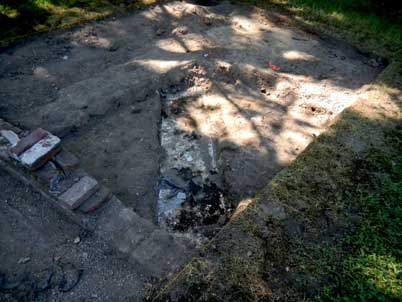
Porch area showing pipe trench with styrofoam.
As mentioned previously, this area was excavated over 30 years ago and stopped at a layer thought to be a midden. The black plastic, which we use to mark where the excavation ended, is almost gone. Only small fragments remain. However, the stryrofoam used to line a pipe trench, as seen in the center of the photo, is as good today as when it was first laid down. I am being very careful in removing the backdirt from this area as the underlying soil contains many 17th-century artifacts. As careful as I try to be, some things have been disturbed that hint at the types of artifacts here.
The first of these is a large piece of tin-glazed earthenware
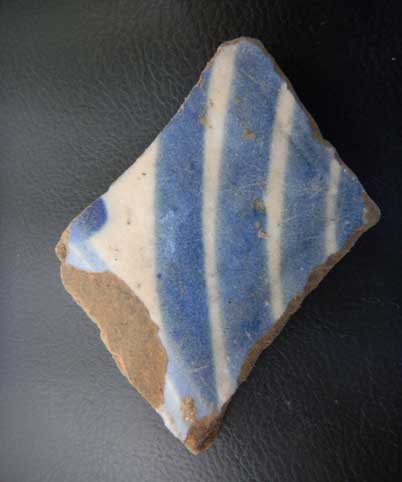
Large tin-glazed eartherware sherd.
This was one of the most common ceramics in the 17th century but it was fragile. Most of the pieces we find in the plow zone are less than an inch long. This pieces is huge in comparison, almost three inches long.
The second artifact was a large piece of German stoneware.
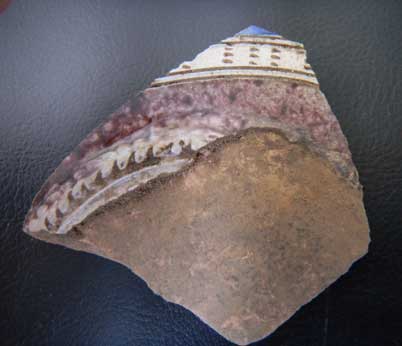
Rhenish blue and grey stoneware fragment with added manganese
and incising.
This is identified as Rhenish blue and grey, based on its decoration. It is highly decorated. In addition to the normal colors, manganese has been added to produce the purple color. It has both molded and incised decoration as well. We would love to see more of this vessel.


